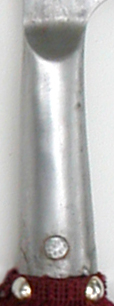Vital Statistics
Length of Blade: 17”
Length of Blade & Socket: 20.5”
Length of Blade, Socket & Langets: approx. 36”
Length of Finished Weapon: 7’6”
Weight of Finished Weapon : 4 lbs
POB: 35” from tip (near the next-lowest rivet of the langets)
Max thickness of blade: 2.5/16ths”
Modification of the Head
The blade is excellent, featuring proper temper and appropriate distal taper. The socket and langets are not as pictured in recent MRL catalogs, however. The socket is plain and the langets are obtrusively welded to the outside of the socket to allow the purchaser to simply stick the head on the end of a pole and pin the langets to the surface of the pole. As shipped, the langets were oriented with the edge and back of the blade, and I wanted them on the sides of the weapon. I sawed off the langets and sawed/ground down the welds. So, my langets are not attached to the socket, and that’s not historically accurate. Historically, secondary langets were not necessarily attached to the socket, but the primary langets almost always were, as far as I can tell. Fortunately, my tassle conceals this shortcoming.
Preparation of the Haft
Ash is preferred, but I used a round poplar dowel for convenience. I carved the end of the haft so that the transition between the wood and the socket of the head would be as seamless as possible. Then I flattened both sides of the haft so that the overall cross-section is a more appropriate round-ended rectangle. I then inlet the langets (an almighty time-suck, let me tell you). The inletting not only looks better and is more historically accurate, but also improves the weapon’s handling by allowing the user to easily slide a hand all the way up to the base of the blade to shorten the weapon as needed.
Mounting
Historically, socket and langets could be riveted to the haft (the rivet passing all the way through the haft and facing steel,) but seem more commonly to have been pinned. I chose to rivet because rivets hold the langets tightly in their channels. Plus, I like the hammered finish of the rivet heads (I use ordinary bright steel nails for the rivets). It would be harder to get that look with pins. I’d have to hammer the heads in a vise first, I think. Anyway, each langet had three pre-drilled holes, which seemed too few compared to historic examples. After placing rivets through the existing holes I simply marked two new holes per langet, then drilled straight through one langet and the haft and out through the other langet. Then I just popped two more nails through and peened them down tightly, as with the other rivets. I put a single rivet through the socket as well.
Tassle
You can find the raw material-a coarse fringe sold by the yard in various colors-at Hobby Lobby and probably most equivalent craft stores. The strands of the fringe are looped, so you need to cut through the end of each loop with a craft knife and separate the strands. Separating the strands makes the finished tassle much fuller and more authentic-looking. Once you’ve separated the strands, just wind the material onto the haft where you want it, creating multiple layers until the tassle is as full as you desire. Then simply pin it in place with four brass or steel furniture tacks and trim the excess length. I think my tassle required four layers (much less than a yard of fringe). This looks pretty convincing to me, and I can’t imagine getting a better result with off-the-shelf materials. It looks better with the weapon upright so that the fringe is evenly distributed around the haft.
Finish
I gave this piece a light antiquing inspired by 16th century polearms in the regional armory in Graz, Austria.
Tools
Wood-shaping rasp (like a giant, slender cheese grater)
Electric drill (for drilling holes for the rivets. NOTE: A metal bit will drill through wood, but a wood
bit will not drill through metal)
Chisel (for fine inletting work)
Dremel Tool (for cutting off the langets, grinding the welds on the socket and rough inletting work.
If you don’t have access to one of these miracle-tools, use a hacksaw, file and chisel. Then
you’ll believe me when I tell you that a Dremel Tool will actually pay for itself in time savings. If you already have a drill, I
guess you could still use Dremel bits for coarse work such as cutting/grinding steel.)
Sandpaper
Ball-peen hammer
Anvil (you can use a sledge hammer head, but Harbor Freight stores sell a little 15 lb anvil for less than $20 USD.)
[ Download ]
